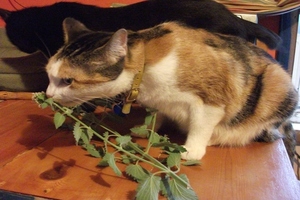Like most cat owners, I buy catnip filled toys for my cats and sometimes buy a bag of dried catnip and sprinkle on the floor for them to enjoy. But there’s nothing better than a fresh sprig of catnip to really make my cats happy. I have a nice size plant growing in my yard alongside my garden the resident neighborhood cats like to enjoy from time to time, and there’s plenty to share with them and my cats. Besides, I get a chuckle watching any cat enjoying the plant. Some cats go bonkers when they are around catnip, but does it really make a cat high?
Not all felines like catnip and it affects cats differently. It can alter their behavior and cause aggressive reactions in some cats. One of my cats can become so aggressive, he will attack one of the dogs if they get too close to his “stash” of catnip. Other cats could care less and some become more playful or mellow. It’s the essential oil, Nepetalactone found in the leaves and stems that attracts cats to the plant.
The catnip plant
Catnip is a member of the mint family, but it’s not one of the more aromatic plants for us to smell. To me, it’s a musty mint smelling herb and it has other uses besides as a mood altering weed for cats. There’s around 250 species of catnip, but the one cats like the best is the Nepeta Cataria species. Catnip is not a native plant and was brought to North America from Europe, Africa, and Asia. However, it grows well in our environment and is widespread across America and Canada. It’s also known as catswort or catmint. All plants in the mint family are easy to grow and hardy enough to make through the cold winter months.
Fresh vs dried
Dried catnip is found in many cat toys and you can buy it in bag form in most stores that sell pet supplies. My cats seem to enjoy chewing and playing with a fresh sprig of catnip over the dried herb in a cat toy. However, most cats that enjoy catnip don’t care if it’s fresh or dried.
How it affects cats
Nepetalactone is an essential oil found in the leaves and stems and is what attracts cats to the plant. Felines that are stimulated by catnip don’t need any encouragement to play with a catnip toy or the fresh herb. They begin by rubbing their face on a toy and may lick it before getting into their catnip antics. When a cat is given fresh catnip, they begin by sniffing it and biting the leaves. Then they may rub their face against it. After rolling around on the plant for awhile, most cats will finally nibble on it and some will eat it.
Fresh catnip doesn’t have much of an odor until the leaves are bruised. Cats roll on the leaves and bite them to release the oil which brings out more of the odor. A cat’s “high” will last about 10 minutes. For cats that eat catnip, it acts like a sedative and the cat goes away to rest. When the effect wears off, she’s back and ready for more.
Scientists aren’t really sure why cats get a “high” from catnip, but they believe it’s because the oil acts like a cat pheromone and causes some cats to react to it. Only around 50 percent of cats find catnip to be alluring, and 33 percent could care less about it. It’s believed a like or dislike to catnip is hereditary. It doesn’t matter if a cat is male, female, has been fixed or is still intact. All cats, domesticated and wild, respond to catnip in the same way. For the most part, young kittens under 8 weeks of age, and older cats aren’t affected at all by catnip, but there’s always exceptions.
Despite claims that have been made, catnip is not a distant relative to marijuana and is only related biochemically to marijuana and other hallucinatory drugs. Never give your cat marijuana or any other drug. Cats don’t react at all to it and the drug can make her extremely sick or cause death.
Other uses for catnip
The plant has a soothing effect for humans, as well as for cats, and can be brewed into a calming tea to drink. Because of its sedative properties, catnip tea can help with insomnia. Catnip can be used to help calm an upset stomach, treat headaches, migraines, help control coughing, and relieve symptoms of asthma. It has a natural healing ability and can be used on cuts, for muscle aches and pains, toothaches, hemorrhoids, as an antibiotic, astringent, as well as other uses. Some people use it in salads and to enhance their cooking. Pregnant women should consult with their doctor before using catnip.
The active oil in catnip, Nepetalactone, is more effective in repelling mosquitoes than DEET and is 10 times better. It can also help chase away cockroaches, rats, and mice. Like the other members of the mint family, catnip helps repel fleas, as well.
Catnip is perfectly safe for your cat to ingest and roll around on as long as she doesn’t get carried away and eat too much. If she vomits or has diarrhea after eating it, don’t let her have it unsupervised and limit the amount she can have. Most cats will not overdo it and stop before problems occur. In other words, it’s a “high” your cat can control and it’s not addictive.
Garden Plants that Get Rid of Fleas the Natural Way
Can Dogs and Cats Get Poison Ivy and Give it to Us
Natural Relief for an Itchy Dog’s Hot Spots



